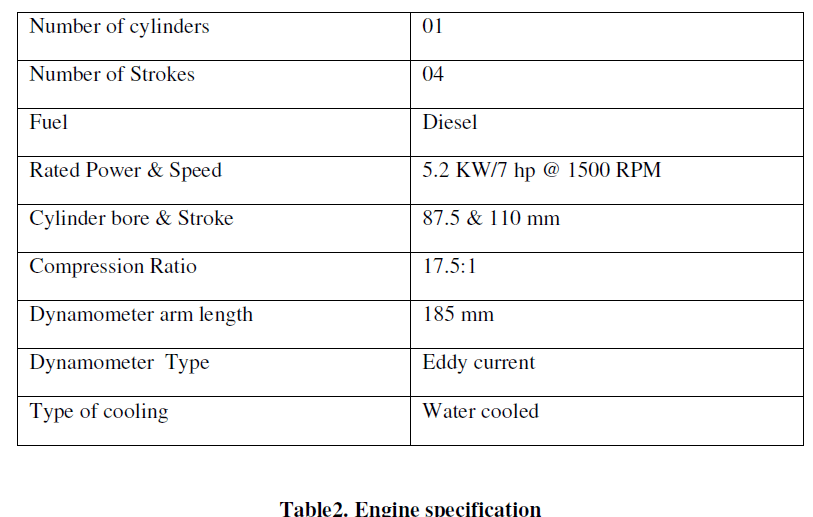ISSN ONLINE(2319-8753)PRINT(2347-6710)
ISSN ONLINE(2319-8753)PRINT(2347-6710)
M. Vijaya Nirmala1, A. Aruna Kumari2
|
| Related article at Pubmed, Scholar Google |
Visit for more related articles at International Journal of Innovative Research in Science, Engineering and Technology
The depletion of fossil fuels and its emissions prompted the researches to conserve the fossil fuel and their controlled combustion. In this connection to achieve the said condition one of the operation parameters like in cylinder Air flow motion has considered. Hence, in the present work the experimental Analysis has been carried out to study the impact of in cylinder swirling flow using both fossil and renewable fuels. For this, the experiment is carried out on the four stroke single cylinder water cooled diesel engine using both diesel and biodiesel fuels with varied piston geometry. In this work an attempt is made using hemispherical piston bowl and flat piston without any change in clearance volume. The swirl motion is created by modifying the inlet manifold. The performance and emission characteristics obtained are presented in the results
Keywords |
| Diesel Engine, Air Swirl, Cylinder, Efficiency, Emissions. |
INTRODUCTION |
| Researchers around the world have made several attempts to find various alternative and renewable sources to replace the existing petroleum diesel fuel. Alternative fuels such as solid, liquid and gas..Biodiesel from different vegetable oil and Animal tallow in the form solid, liquid and gas used to run IC engine. Although these fuels are used, they generate considerable pollutants from IC engines. Among the researchers vegetable oil found to be cleaner fuel where trees are available in plenty and renewable in nature. Liquid fuels like Alcohols are the derivatives of vegetable oils and animal tallow are the best example of category. Alcohols are of 2 types, ethanol and methanol. Advantage of their use gives overall fewer emissions compared to Diesel and Gasoline. Methanol it self is not a good CI fuel because of its high octane number but in small amounts of diesel oil used for ignition. |
| Minor engine modification is needed for blends containing more than about 20% alcohol or for almost pure alcohol. These results increase in compression ratio and altered timing etc. crude oil production in the country as given in the eleventh five year plan is shown in the table 1. The production of crude oil in India is estimated to have a decreasing trend after the year 2010 as can be seen from the table 1. But there is an increase in the vehicle population every year which demands an increase in crude oil imports. Add to that the hike in prices of petrol and diesel is greatly observed these days. Indiscriminate extraction and lavish consumption of fossil fuels have led to reduction in underground based carbon resources. With this scenario the need for an alternate fuel to maintain the economy of the country. |
| Recent reports says that lower smoke levels higher the thermal efficiency which is obtained by methyl esters of vegetable oil. Also thermal efficiency increases with increase in the methanol fraction in diesel. Due to increase in fraction of premixed combustion phase with marked reduction in CO and HC emissions. These days in transportation sector Diesel ranks in high fuel consumption. Vegetable oils have proved to be more feasible alternative in this regard, because they can be produced from the plants grown in the rural areas. Intensive research is going on through the globe for a suitable diesel substitute. In this race among different alternatives, vegetable oils have attained primary place as some of their physical, chemical and combustion related properties are nearly similar to that of diesel fuel |
 |
II. MATERIALS AND METHODS |
| In this project we tried to investigate the potential use of Palm Stearin Methyl Ester (PSME) and Animal Tallow Methyl Ester (ATME) as bio-diesel. A brief introduction about the material used in this project given below Palm Oil is an environment friendly, renewable energy source that could also produce cost savings for taxpayers and private businesses and is produced from palm trees. The Palm Oil that is "harvested" and produced from palm trees is referred to as "Crude Palm Oil." The crude palm oil is then shipped to refine by a palm oil refinery. The output is referred to as refined palm oil which is suitable to be used as a biodiesel fuel. |
| Animal Tallow Methyl Ester (ATME) |
| Animal Tallow used for production of Biodiesel Animal Tallow can be used for biodiesel production as easily as Plant Oils. About 14 MT of Tallow is available globally. Tallow as a unique feedstock has certain properties that are hard to reproduce from plant oil. |
 |
A. ROLE OF SWIRL IN DIESEL ENGINE |
| Most important function of CI engine combustion chamber is to provide proper mixing of fuel and air in short possible time. For this purpose an organized air movement called air swirl is to be produced to produce high relative velocity between the fuel droplets and air. Swirl is what is taking place when the intake charge exits the intake valve and enters the combustion chamber. As the air enters the combustion chamber and the piston travels down in the bore, it causes a spiraling effect. The air in the spiraling effect actually travels around the bore such as water goes around in a flushing toilet. This effect is used in helping to fill the cylinder. It is swirl that controls the engine’s output and rpm. |
| Swirl, considered as a two-dimensional solid body rotation, persists through the compression and combustion processes. Many researchers have demonstrated that the decay of swirl in an engine cylinder during the compression process is relatively small so that the overall angular momentum of the swirl vortex is almost conserved |
 |
 |
B. MODIFICATION OF ENGINE |
 |
III. EXPERIMENTAL PROCEDURE |
| The present work is planned with the following objectives: |
| The present work is carried out to evaluate the use of palm oil methyl ester and animal tallow (biodiesel) in a four stroke, direct injection (DI), single cylinder KIRLOSKAR diesel engine located in the college laboratory having a rated output of 6HP working at constant speed of 1500 rpm and at various load conditions. |
| The performance of the engine using palm oil methyl ester, Animal Tallow and diesel are compared. |
| Also the performance of the engine with different swirl motions with varied piston geometry is examined. For this the series of tests are conducted initially with the pipe used to connect inlet manifold and air chamber with no turns and then with 3, 5 turns. This has been done for engine fuelled with the diesel and biodiesel. |
IV. INVESTIGATION ON VARIED PISTON GEOMETRY WITH CONTROLLED AIR FLOW MOTION OF IN-CYLINDER |
A. BRAKE THERMAL EFFICIENCY |
| The brake thermal efficiency with brake power for varied piston geometry and swirl motion of 3 and 5 turns are compared with the normal engine and is shown in fig.2. The brake thermal efficiency for normal piston at full load is 29.8%. It can be observed that the engine with hemispherical piston and flat piston give their thermal efficiencies of 31.8% and 30.8% respectively, at full load. It is observed that there is a gain of 2% with flat piston compared to normal engine. The thermal efficiencies of hemispherical piston and flat piston are lower compared to that normal engine. From fig4.1 it was referred that the brake thermal efficiencies were increasing with an increase in brake power for hemispherical piston which are under consideration. These configurations were found to offer better thermal efficiencies than the normal engine. This might be due to the enhanced mixing rate in the case of hemispherical piston carried by turbulence in the combustion chamber. |
Graphs for normal diesel engine |
| Piston1-Hemispherical |
| Piston2-Flat |
| PSME- Palm Stearin Methyl Ester |
| ATME-Animal Tallow Methyl Ester |
i. ENGINE PERFORMANCE |
 |
ii. ENGINE EMISSIONS |
A. HYDROCARBON EMISSIONS |
| The comparison of hydrocarbon emission in the exhaust is shown in fig.4 Un burnt hydrocarbon emission is the direct result of incomplete combustion. It is apparent that the hydrocarbon emission is decreasing with the increase in the turbulence which results in complete combustion. At the rated load with hemispherical Piston the maximum reduction of hydrocarbon emission level is observed and is about 66% compared to normal engine. |
| CI engine also have HC emission for i.e., wall deposit absorption, oil film absorption, clearance volume etc. HC goes up as Oil consumption increases. This increases Oil consumption contributes to increases in HC emission as the piston rings and cylinder wall wear. |
 |
B. CARBON MONOXIDE EMISSIONS |
| Fig.5 shows the comparison of Carbon monoxide emission with brake power. Generally, C.I. engines operate with lean mixtures and hence the CO emission would be low. With the higher turbulence and temperatures in the combustion chamber the oxidation of carbon monoxide is improved and which reduces the CO emissions. The lowest carbon monoxide emission is with hemispherical piston geometry of 5 turn swirl motion. It is observed that with hemispherical piston and flat piston the reduction in CO levels is about 1.22% and 2.10% respectively compared with normal engine i.e. 3.017%.CI engines that operate overall lean generally have very low CO emissions. |
 |
C. OXIDES OF NITROGEN ( NOx ) EMISSIONS |
| The comparison of NOx depends on pressure and air-fuel ratio. Combustion duration plays a significant role in NOx formation within the cylinder, the temperature will be increase and more NOx will be created, because CI engine have higher compression ratio, higher temperature and pressure and more NOx generated. |
 |
V. CONCLUSIONS |
| In the present work, experiment are carried out on four stroke, water cooled and single cylinder stationary engine. In this two different piston geometry are used by varying the Air swirl motion of in-cylinder. The following conclusions are drawn. |
| The varied piston geometry of hemispherical piston enhances the turbulence and this is due to better air-fuel mixing process. The thermal efficiency is increased and where as SFC and soot emissions are reduced. The NOX emissions are reduced because of better mixing and a faster combustion process. Swirl motions with 3, 5 turns are evaluated and found for hemispherical piston better performance. |
| The brake thermal efficiency has been increased for hemispherical piston is 31.8% and for flat piston is about 30.8% The indicated thermal efficiency has been increased for hemispherical piston is 30.99% and for flat piston is 35.96% |
| The specific fuel consumption has increased for hemispherical piston is 0.354kg/kw/hr and for flat piston by 0.398kg/kw/hr. |
| Volumetric efficiency is reduced by hemispherical piston is 98.11% and flat piston by 99.37% |
| Biodiesel reduces particulates of carbon monoxide emission compared to diesel fuel. Biodiesel also produce more hydrocarbon emission during experiment this is practically true during starting when air fuel mixture is purposely made very rich. HC decreases with the increases in turbulence hence results in complete combustion. NOx depends on pressure – air fuel ratio .combustion duration plays a significant role in NOx formation within the cylinder. |
ACKNOWLEDGEMENTS |
| The author sincerely thanks Dr. K. Vijayakumar Reddy, Professor, Department of Mechanical Engineering, JNTU college of Engineering Hyderabad, India for support, patience and encouragement that made this experimental work in IC engines. |
References |
|